You have no doubts: You’re certain that you want to nurse your newborns and you are well aware of all the benefits breastfeeding brings to the table.
However, when you’re mothering multiples, breastfeeding twins can sound like a real nightmare. You can’t help but wonder if you can manage it. Will you be able to nurse two babies at the same time?
Well, I’m here to promise you one thing. Nursing multiples is possible and once you get used to it, it becomes a piece of cake.
Here are all the tips and tricks for breastfeeding twins you should know.
1. Breastfeeding essentials
The good news here is that we live in modern times.
In comparison to the past, you don’t have to do all of the hard work yourself (let’s face it – as much as you enjoy it, breastfeeding twins really is hard work.)
In fact, there are numerous tools and aids that come in handy in this kind of situation.
Of course, you can use each one of them while nursing a singlet as well.
However, only when you are feeding twins do you realize how blessed you are to live in an era where all of these things are so available.
Believe me, these breastfeeding essentials will become your best friends and once you try them, you won’t be able to picture your motherhood without them anymore!
Breastfeeding pillow for twins
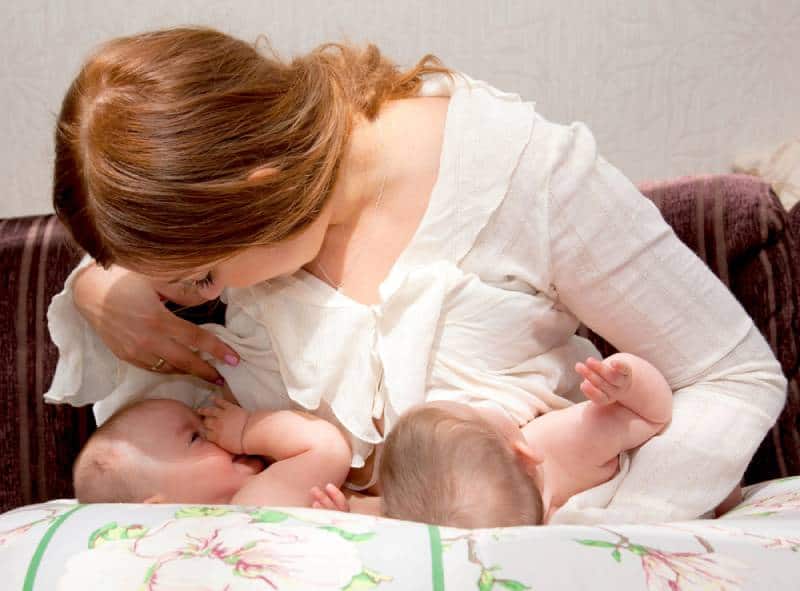
The name says pretty much everything.
This is a pillow that helps you nurse. A breastfeeding pillow has one goal: to keep the baby positioned high and as close as possible to your breasts.
It puts the baby in the right position and it helps both of you enjoy this nursing experience with more ease.
Even so, many experts will tell you to try and master the art of breastfeeding in a natural position – holding your newborn in your arms – before reaching out to any aids.
This way, you’ll achieve more intimacy with your newborn.
You’ll feel that you’re in charge and that you have better control over this wonderful yet demanding process.
Once you perfect this, switching to a nursing pillow will be a breeze. There are numerous benefits to using one.
First and foremost, a feeding pillow helps with the latching process.
Also, if you’ve just had a C-section, it creates a type of barrier between you and the baby, which can help you while healing.
The three things you should pay attention to while buying this pillow are material, cover, and texture.
The material has to be adapted for newborns, so it can’t contain any toxic substances.
Whatever your pillow is made of, make sure it’s not too soft or too hard. Remember, it has to be mold around your babies’ heads.
Another thing you shouldn’t forget about is the cover.
You’re probably crazy about some interesting designs or colors but please, in this case, put functionality first.
Believe me when I tell you that you’ll probably have to change this cover literally a few times a day, especially with you having two kids.
So, do you prefer having a nice design for a couple of days or not having to deal with burp stains?
Knowing all of this, I’m sure you understand that the cover should be replaceable and easily taken off.
After all, you won’t want to have to clean and dry your entire pillow every time your babies make a mess.
When it comes to feeding twins, it would be absurd to get two separate pillows.
I’m not telling you this just because I want to give you a financial piece of advice, but because it is practically impossible to juggle these two pillows simultaneously.
Instead, what you should get is a specialized twin feeding pillow – one pillow with more supportive arms and space for positioning two babies.
That said, it’s important to follow your babies’ lead here. Remember that not all mothers and newborns enjoy the same things.
Therefore, there is nothing wrong with you or your babies if you don’t feel comfortable using a nursing pillow.
Find what works best for the three of you and follow your gut – it always knows what’s right.
My personal pick:
- FEEL THE SUPPORT: Encourages better posture during breastfeeding, alleviating strain in your back, neck, and arms
- ALLOWS FOR TANDEM NURSING: Large design is big enough to comfortably support both twins during breastfeeding. Dust-free, Scratch Proof and Anti-reflective
- CONVENIENT POCKET: Handy pouch keeps your maternity supplies within easy reach
- WRAP AROUND DESIGN: Adjusts to fit most sizes, My Brest Friend surrounds your body securely, for the ideal position, providing the best support for mom and babies
Prices pulled from the Amazon Product Advertising API on:
Product prices and availability are accurate as of the date/time indicated and are subject to change. Any price and availability information displayed on [relevant Amazon Site(s), as applicable] at the time of purchase will apply to the purchase of this product.
Breast pump
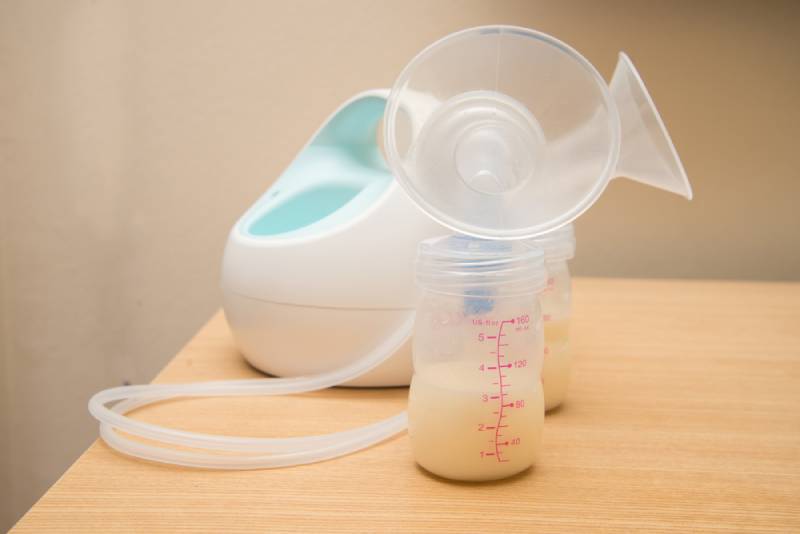
As you read on, you’ll understand that a breast pump won’t only serve you in cases where your babies aren’t getting enough milk.
While many moms use it for this initial purpose, this breastfeeding essential will prove to be a real lifesaver for numerous other reasons.
First and foremost, it can increase your milk supply, since you’ll use it to stimulate more milk production.
Also, it comes in handy later on when you can’t be physically present next to your twins all the time.
This way, you can express the milk and leave it to someone else to feed the babies.
Some women are scared of this device since they assume it’s painful to use.
I won’t lie to you, in the first few seconds of using it, your nipples will start to stretch and that might cause an uncomfortable sensation.
However, before you know it, you’ll get used to the feeling.
Breast pumps can be manual or electrical. Manual pumps are cheaper and noiseless.
Nevertheless, since you have twins and you’ll probably need to pump more frequently, using them can become a little difficult.
You see, you’ll have to manually pump consistently in order to create the vacuum and get the milk going.
That’s why in your case, a hospital-grade electric pump might be the best solution – and it’s not a bad idea to go for a double pump instead of a single.
Yes, it is more expensive, but here the motor does the job for you, which makes the entire process much easier and faster.
Expressing the necessary amount of milk for two babies will probably take you 15-20 minutes per session if you’re using an electrical pump.
But even when you don’t have this amount of time, don’t worry because only a few minutes are enough to maintain your milk supply.
A good piece of advice is to keep pumping for a few minutes after the last drops of milk are out. Actually, this is exactly what keeps your milk supply up.
Here are my top picks:
| Image | Title | Price | Prime | Buy |
|---|---|---|---|---|
 | Medela Pump in Style Advanced Breast Pump with Metro Bag | PrimeEligible | Buy Now | |
 | Spectra Baby USA S1Plus Electric Breast Pump | Prime | Buy Now |
Breast shells

If you happen to have leaky breasts or inverted or sore nipples, breast shells are the solution to your problems to avoid painful breastfeeding.
Since you have two babies sucking on your nipples, it’s quite likely that you’ll face one of these troubles sooner or later.
Breast shells or milk collection shells are amazing because they allow your nipples and breasts to recover from all of that feeding and they protect them from chafing on your clothes.
These are actually plastic or silicone disks you gently yet firmly apply over your areolas.
Not to be confused with nipple shields, you don’t use breast shells during the actual breastfeeding – they are intended to be worn before and after nursing.
Here is my top pick:
- PAIN RELIEF! These breast shells don’t touch your nipples allowing for healing time between nursing and pumping sessions. Ideal to get a break from friction and irritation that sore nips can experience with the constant demands of breastfeeding. They act as a nippleshield !
- NO MORE LIQUID GOLD WASTED! Every drop counts. These breast milk catchers are especially helpful early on when every drop is needed! Use these all throughout the day in between pump and breastfeeding sessions to build your milk stash effortlessly! You’ll be amazed how many ounces you can collect in a day
- COMFORTABLE & DISCREET. These cups are so comfortable you won’t even remember you’re wearing them. They fit any size of nursing bra discreetly and go unnoticed while you’re collecting milk for your baby!
Prices pulled from the Amazon Product Advertising API on:
Product prices and availability are accurate as of the date/time indicated and are subject to change. Any price and availability information displayed on [relevant Amazon Site(s), as applicable] at the time of purchase will apply to the purchase of this product.
2. Find the best nursing position
The most essential thing when it comes to breastfeeding twins is finding the perfect nursing position that will suit both you and your babies.
However, the good news is that nobody tells you that there’s only one breastfeeding position for all twin moms out there.
In fact, it’s your job to try out different positions and see which one of the various breastfeeding twins positions is best for you.
Just keep in mind that your newborns will grow, so it is likely that you’ll have to change positions during the first year of their lives, according to their growth.
Regardless of your chosen position, there is a pattern you should follow before feeding your twins. First of all, get yourself as comfortable as possible.
Prepare all of the essentials you need. Don’t forget to keep a change of clothes for you and your twins nearby (expect a lot of burps!)
Take the nursing pillow, fasten it around your belt, and put both babies in it, one at a time. If you’re not alone, it helps to have someone else hand you the little ones.
Double football hold
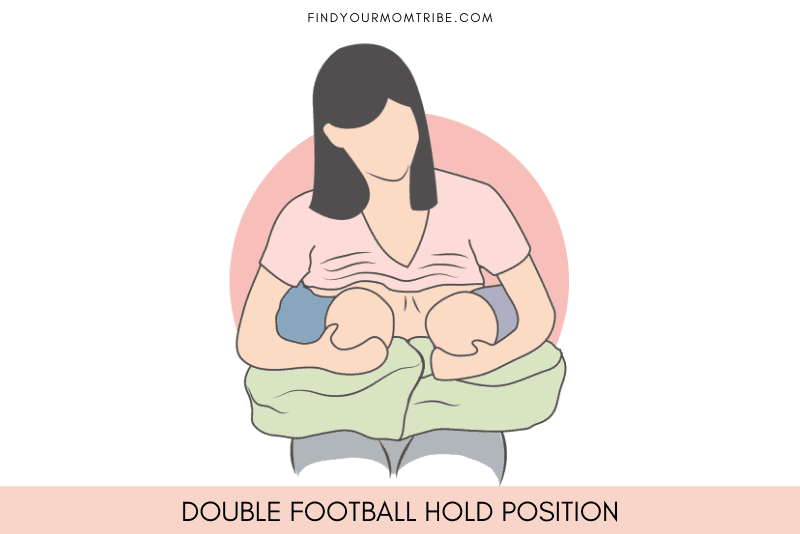
To achieve this football hold position, you’ll need to have both of your babies faced upwards.
Place the first baby in your right arm and the second in your left, with their legs tucked under your arms.
Use the palms of your hands to support your babies’ necks.
Once you’ve done that and when both babies are positioned as closely as possible to both of your sides, gently pick up your twins and bring them to your breasts.
Double cradle hold
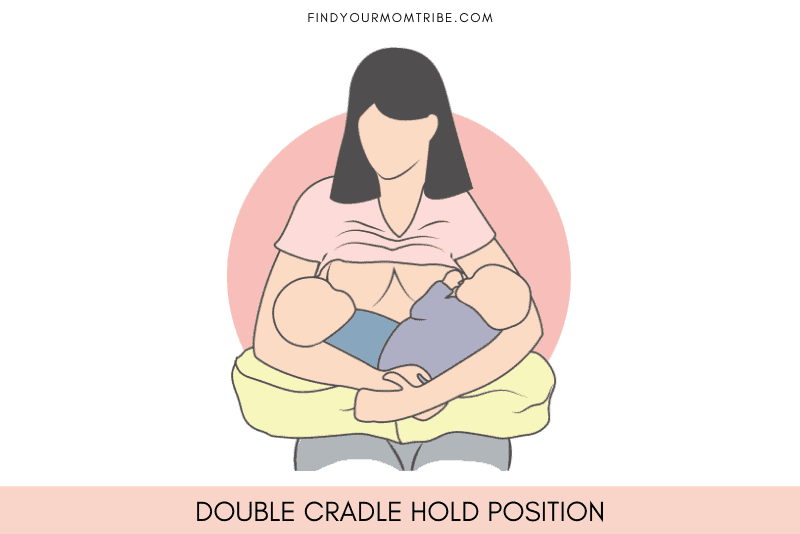
In this position, the key is to support your babies’ heads with your elbows, while supporting their chests with your arms.
Sounds complicated, but it is actually the most common nursing position that moms use.
Basically, the key is to keep both of your newborns chest-to-chest to yourself since it gives the babies the best possible support.
3. Don’t panic
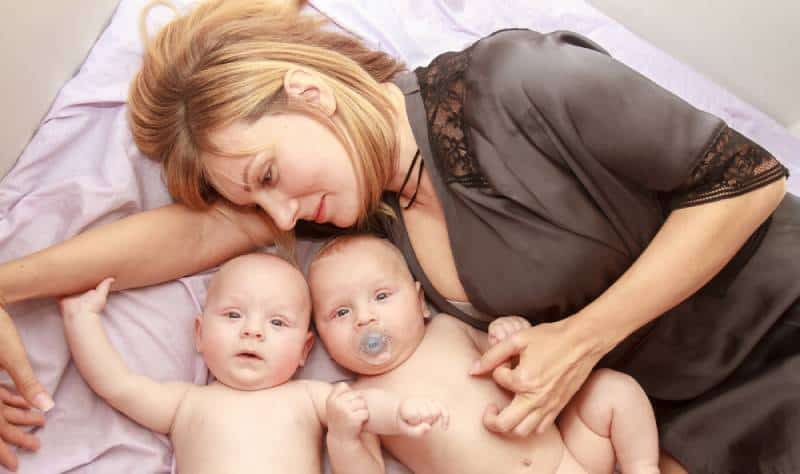
Breastfeeding is a magical, bonding, one-of-a-kind experience between a mother and her baby.
Nursing sounds like a cakewalk for those who still haven’t experienced it.
After all, what could possibly go wrong in this natural process? Your body possesses this amazing ability to give food to your child.
It seems pretty simple, doesn’t it? You feed your baby with breast milk coming out of your body, so what is the big deal?
However, let’s be honest here.
Breastfeeding is not always as easy as it might appear at first. In fact, it takes a lot of effort, hard work, and patience to get that milk to your baby.
With that in mind, nursing two babies at the same time might seem like mission impossible. After all, mothering multiples is hard enough, let alone breastfeeding them.
This is especially true for primiparas (first-time moms) who don’t have any practical experience whatsoever in parenting or breastfeeding.
Will I have enough milk production? Will I end up feeling like a dairy cow?
Will I be able to give the same amount of attention to both babies?
Is it physically possible for me to nurse two babies at the same time?
Will I be too tired? Will this experience exhaust me completely?
What if I had a C-section? What if my babies are born prematurely?
You have all of these questions running through your head and it’s overwhelming, to say the least.
Therefore, it’s completely natural that, at first, you feel like you don’t have a clue what you’re doing. It’s normal to feel scared and think that you’ll never get all of it right.
Well, despite what you might feel, I’m here to assure you that there is absolutely nothing to worry about.
Please, do your best not to panic because you’ll soon realize that there is actually nothing to be afraid of.
Instead of wasting your precious time on overthinking, believe in yourself. After all, you’re a mum and who can know what suits her rays of sunshine better than you?
When you’re in a dilemma, just follow your gut.
Even though you might have some self-doubt now, trust me, your maternal instinct is there to guide you through this beautiful and intimate journey.
And most importantly, you’re not alone. We’ve got your back and are here to give you all the support you need!
Basically, what I’m trying to tell you is that nursing twins is possible, even though it might not seem that way now. I promise you that you will master it – just don’t give up!
4. Prepare yourself

You know how they say practice makes perfect?
Even though I completely agree, when it comes to breastfeeding twins, preparation is also key to breastfeeding success.
Since you’re here, I’m sure you’ve already acquainted yourself with all the benefits of breastfeeding.
You’ve also decided that nursing is the best way to feed your babies and you know you’re carrying twins.
All moms prepare for their little munchkin’s arrival. You buy diaper bags, think of baby names, and take birthing classes.
Even though all of this is amazing and essential, there is another significant thing you mustn’t forget during this process: breastfeeding preparation.
If it’s possible, the best way to do it is to enrol yourself in breastfeeding classes and join support groups that will provide you with the training and support you need.
There you’ll encounter different experts such as doulas and lactation consultants who are informed about all the dilemmas you might have and will give you all the answers you seek.
It doesn’t matter if this isn’t your first pregnancy and if you breastfed your first baby.
This experience will be way different and that you could do with all the pre-knowledge you can get.
It would be best if you could get yourself to complete the breastfeeding class by the 36th week of pregnancy.
This way, you’ll be prepared even if your babies arrive before your due date.
Also, it would be a good idea to be informed about your nipples. You see, many women are struggling with inverted or flat nipples, which bring a lot of problems with nursing.
If this is the case with you, it’s better to notice this on time and deal with this issue before you start breastfeeding.
Don’t worry, this doesn’t mean that you are unable to breastfeed, just that you will need to adjust your nursing strategy.
5. Start your breastfeeding journey ASAP

Most doctors, pediatricians, and lactation consultants will tell you that, ideally, breastfeeding should begin as soon as the baby is born.
In fact, most full-term and healthy babies can be nursed a half-hour after they’re born.
This applies to natural labor.
On the other hand, when it comes to a C-section, most experts will advise you to start your breastfeeding journey when the breast milk comes in.
It is a well established fact that there is a milk delay after a C-section, but that you can try to pump milk until it starts coming in normally.
Knowing this, you’re probably wondering why is it essential to start breastfeeding this early?
After all, you’re not just being told to nurse your baby on the first day of their life – in fact, it would be great if you could start during the first hours.
Well, when you begin this early, your baby gets all the positive effects of colostrum.
It is the first food your body produces and can be given to your baby within minutes of birth.
Colostrum contains white blood cells and antibodies, which help build your newborn’s immune system, and it has numerous other health benefits.
It serves as a laxative, as well as provides the right amount of nutrition for your baby’s eyes, brain, and heart.
Also, it is incredibly beneficial for the baby’s digestive system since it builds a tough coating on their intensities and stomach.
Basically, colostrum is the best possible first food for newborns that will provide your little ones with everything they need in the early days of their lives.
And besides all of these health benefits early breastfeeding brings to your babies, it also has a positive psychological effect.
Nursing your newborns in those first few hours creates an incredibly strong bond between the three of you right away.
Another great thing about it is the way it affects you. It gives you a sense of confidence and makes you realize that you can do it.
Gone are all those dilemmas and self-doubts.
It doesn’t matter if you’ve had a professional who helped you and your babies with latching, now you see that nursing twins is possible and you’re very much capable of doing it.
Nevertheless, all of this looks a little bit different when you go through a C-section.
In fact, women who had a C-section need some time to recover and for breast milk to come in.
On the other hand, if your children are premature babies and can’t breastfeed directly from your breasts, that doesn’t mean that you should give up nursing.
In fact, despite this, if you are healthy enough, you should express your milk regularly from your breasts in order to keep your milk supply going.
You can always freeze your breast milk and give it to your little ones later on when they’re strong enough to start nursing.
6. Establish your milk supply
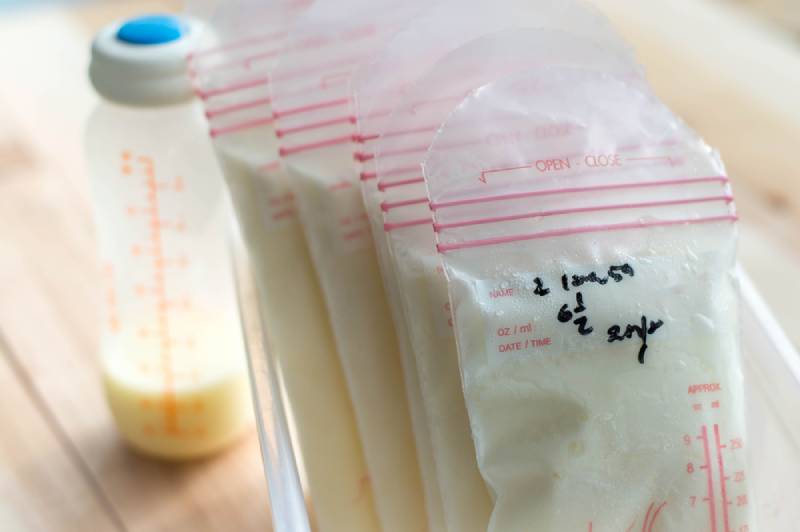
When you’re a mother of twins, the first question you’ll probably ask yourself is whether you’ll make enough milk for both of your babies.
Well, let me give you peace of mind: When you feed twins, your body responds accordingly to this double demand.
After all, this is exactly how breastfeeding works.
Your body produces the amount of milk your baby (or in your case babies) need and want to consume. A true miracle, right?
Nonetheless, the truth is that many mothers of twins usually need a hand when it comes to building their milk supply.
Therefore, if you’re one of them, it doesn’t mean that you won’t succeed in nursing twins, just that you could use the help of a lactation consultant.
In a situation where you have a problem with your supply, it would be a good idea to use that breast pump I spoke of earlier.
You see, the largest amount of milk comes from your breasts in the first few minutes of nursing.
Therefore, it can be useful to have a few shorter pumping sessions during the day, in between breastfeeding your babies.
This is especially important if you can’t reach complete breastfeeding success.
You know that, according to all experts, exclusive breastfeeding during the first six months of a newborn’s life is the way to go.
However, it’s not that simple when it comes to breastfeeding multiples.
Sometimes, despite all of your desire, you simply must supplement with bottle feeding – all the more reason to pump regularly, since it’s the only way to keep your milk supply at the desired level.
7. Your nutrition

I’m sure you’re perfectly aware of how significant your diet is while you’re nursing.
Now imagine how much more important it is for you to have healthy nutrition when you’re breastfeeding twins.
Providing this much milk supply equals burning a lot of calories.
In fact, on average, you’ll burn around 1000 more calories now that you’re breastfeeding multiples. (Of course, it all depends on your weight, activity levels, and metabolism.)
That means that you should eat more.
Naturally, your diet has to be healthy and high in minerals, vitamins, complex carbohydrates, and healthy fats.
Calcium is especially significant here.
Trust me, your nutrition while you’re breastfeeding is as important as it was while you were pregnant.
8. Set up a feeding schedule

Another essential thing about breastfeeding multiples is setting up a feeding schedule that works well for the mother and the babies.
This is what will help keep you sane and the only chance you have of ever getting some sleep (even if we’re only talking about a few hours at a time).
Take my word on this: Begin with this schedule right away after the babies are born. Newborns adopt habits extremely quickly, so if you start feeding your twins without an established nursing pattern, you’ll have a hard time getting a schedule going afterward.
Usually, in the first days of their lives, newborns eat 8 to 12 times a day, which means you should feed them every 2 to 3 hours. It’s a lot to remember so keep track and log these feeding sessions.
This is necessary because babies digest breast milk with ease, so they’re hungry quite often.
Of course, as your babies get older, this schedule changes and they breastfeed fewer times during the day and night.
What is important to remember is to count the time from the moment your babies start to nurse to when they start breastfeeding the next time.
On average, one breastfeeding session lasts around 20 minutes. It sounds like a lot of hard work each day, I know.
However, I promise you that it becomes easier with time and you get into the groove pretty quickly.
Knowing all of this, you now see how important it is to have a good nursing schedule when it comes to breastfeeding twins – unless you want to literally spend an entire day nursing in between your multiples!
In the first few days or weeks, in order to practice latching techniques, you’ll probably have to nurse your babies separately.
But that doesn’t mean that your babies won’t follow a schedule. In fact, you can nurse baby B right after baby A is done.
For example, you can cuddle with one baby while the other is breastfeeding, so none of them feels left out.
- Tandem Breastfeeding Twins

After you’ve mastered the art of nursing one baby at a time, the next advice you’ll get is to breastfeed your newborns at the same time.
This is called tandem nursing: when you breastfeed baby A and baby B on both breasts simultaneously.
What is crucial in tandem nursing is to make sure both babies are well fed every time you nurse them.
Many lactation specialists advise that the best way to give both newborns the same amount of breastfeeding time during the day is to alternate breasts.
You can do this in the middle of each nursing session or you switch breasts at each feeding – the choice is yours and your babies’.
Just follow their rhythms and see what works best for the three of you.
Alternating breasts will help with your supply and prevent the possibility of one of your breasts engorging (overfilling with milk).
After all, despite your babies being twins, they’re still two separate individuals.It’s not uncommon for them to have different appetites and breastfeeding patterns, all of which dictate your nursing schedule.
Therefore, even though you want to follow your schedule, it’s important not to do it blindly. Instead, be attentive to each baby’s needs and milk demands.
9. Ask for help

Finally, I want to reassure you that no matter how much you read about it or how informed you get, you’ll never do everything right the first time.
Breastfeeding twins is a lot of work and it’ll take a couple of failures before you reach success.
However, at the end of the day, don’t forget that you’re not alone in all of this.
Yes, you’re the number one person in your little ones’ lives, but that doesn’t mean you’re not allowed to ask for help.
The first people you should turn to if you have trouble nursing your multiples are trained experts and professionals.
You can start off with a lactation consultant, which is essentially a breastfeeding specialist. Many moms stand by the help of the lactation consultant as very effective and often much needed.
The next person you should reach out to is a doula.
Doulas are usually not healthcare professionals, but they specialize in antepartum or postpartum stages.
Basically, these are the people who will give you the breastfeeding support you need and can make this entire experience much easier.
Then lastly, if you have any further questions or hesitations, have a chat with your babies’ pediatrician.
After all, this is a medical expert who has all the answers you need.
Like this post? Please share or pin it for later. You can also stay in the loop and follow us on Facebook, Instagram or Pinterest.
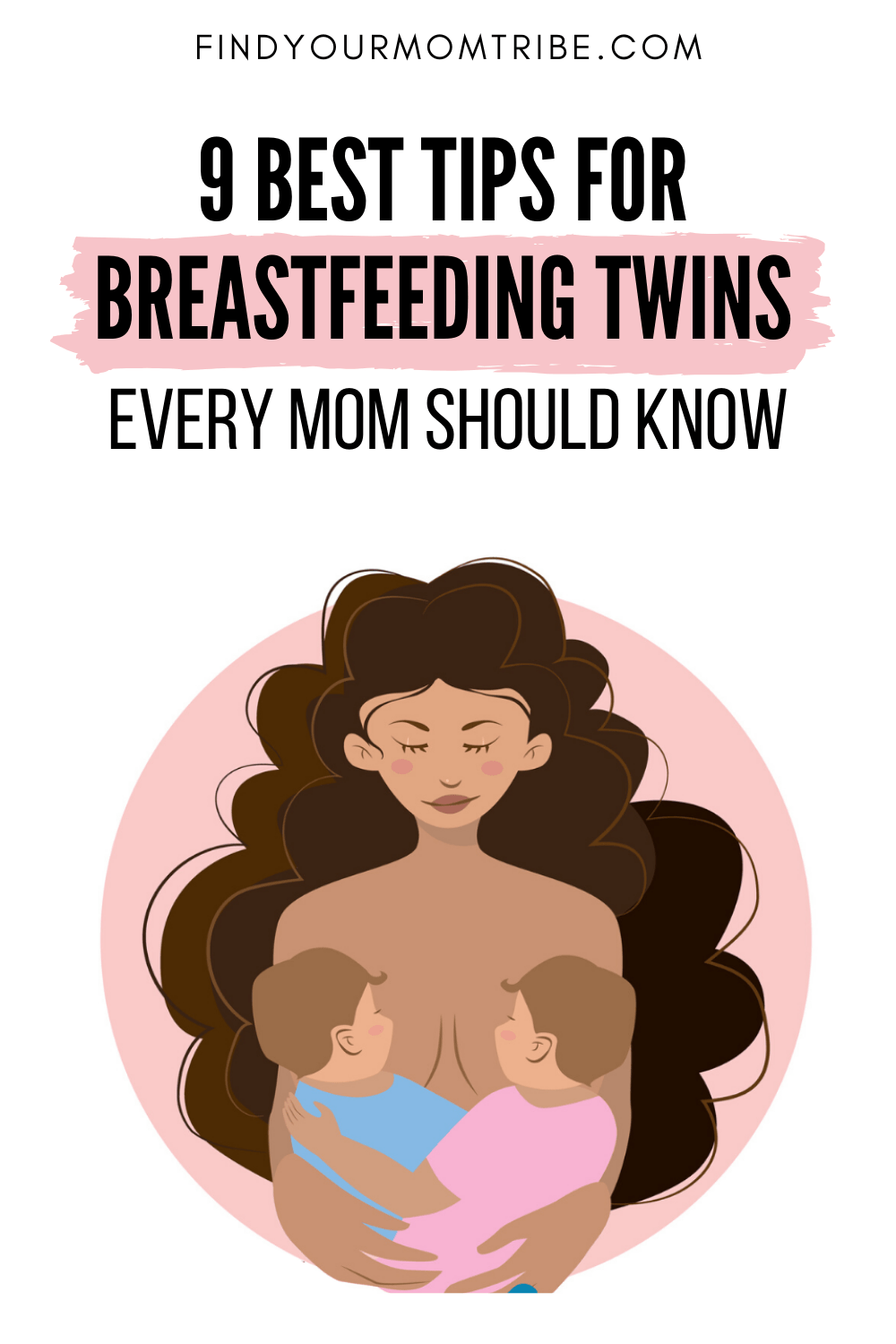
We love honesty! Find Your Mom Tribe is an Amazon Associate and we earn from qualifying purchases through affiliate links at no extra cost to you. Please see our full Amazon Affiliate disclosure for more information.

